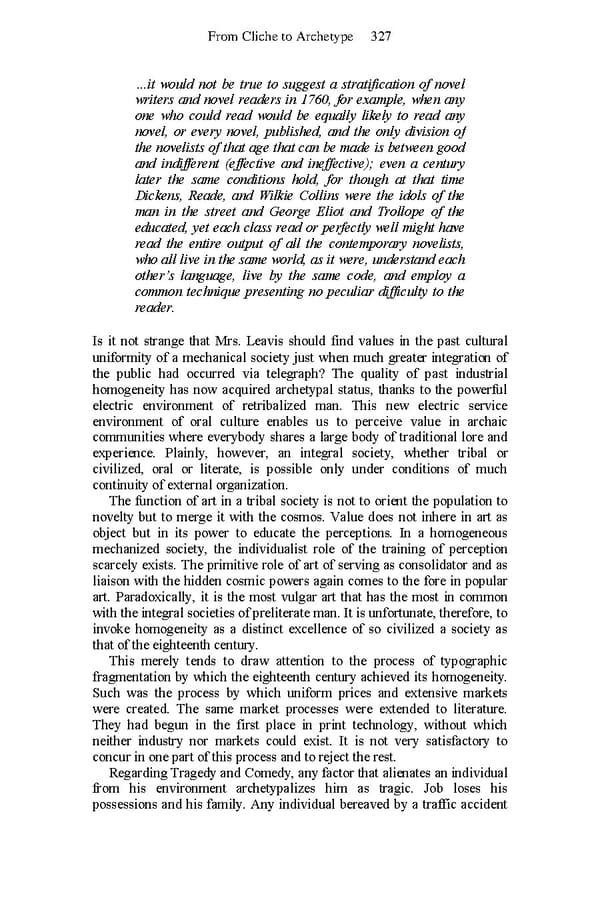From Cliche to Archetype 327 …it would not be true to suggest a stratification of novel writers and novel readers in 1760, for example, when any one who could read would be equally likely to read any novel, or every novel, published, and the only division of the novelists of that age that can be made is between good and indifferent (effective and ineffective); even a century later the same conditions hold, for though at that time Dickens, Reade, and Wilkie Collins were the idols of the man in the street and George Eliot and Trollope of the educated, yet each class read or perfectly well might have read the entire output of all the contemporary novelists, who all live in the same world, as it were, understand each other’s language, live by the same code, and employ a common technique presenting no peculiar difficulty to the reader. Is it not strange that Mrs. Leavis should find values in the past cultural uniformity of a mechanical society just when much greater integration of the public had occurred via telegraph? The quality of past industrial homogeneity has now acquired archetypal status, thanks to the powerful electric environment of retribalized man. This new electric service environment of oral culture enables us to perceive value in archaic communities where everybody shares a large body of traditional lore and experience. Plainly, however, an integral society, whether tribal or civilized, oral or literate, is possible only under conditions of much continuity of external organization. The function of art in a tribal society is not to orient the population to novelty but to merge it with the cosmos. Value does not inhere in art as object but in its power to educate the perceptions. In a homogeneous mechanized society, the individualist role of the training of perception scarcely exists. The primitive role of art of serving as consolidator and as liaison with the hidden cosmic powers again comes to the fore in popular art. Paradoxically, it is the most vulgar art that has the most in common with the integral societies of preliterate man. It is unfortunate, therefore, to invoke homogeneity as a distinct excellence of so civilized a society as that of the eighteenth century. This merely tends to draw attention to the process of typographic fragmentation by which the eighteenth century achieved its homogeneity. Such was the process by which uniform prices and extensive markets were created. The same market processes were extended to literature. They had begun in the first place in print technology, without which neither industry nor markets could exist. It is not very satisfactory to concur in one part of this process and to reject the rest. Regarding Tragedy and Comedy, any factor that alienates an individual from his environment archetypalizes him as tragic. Job loses his possessions and his family. Any individual bereaved by a traffic accident
 Essential McLuhan Page 333 Page 335
Essential McLuhan Page 333 Page 335